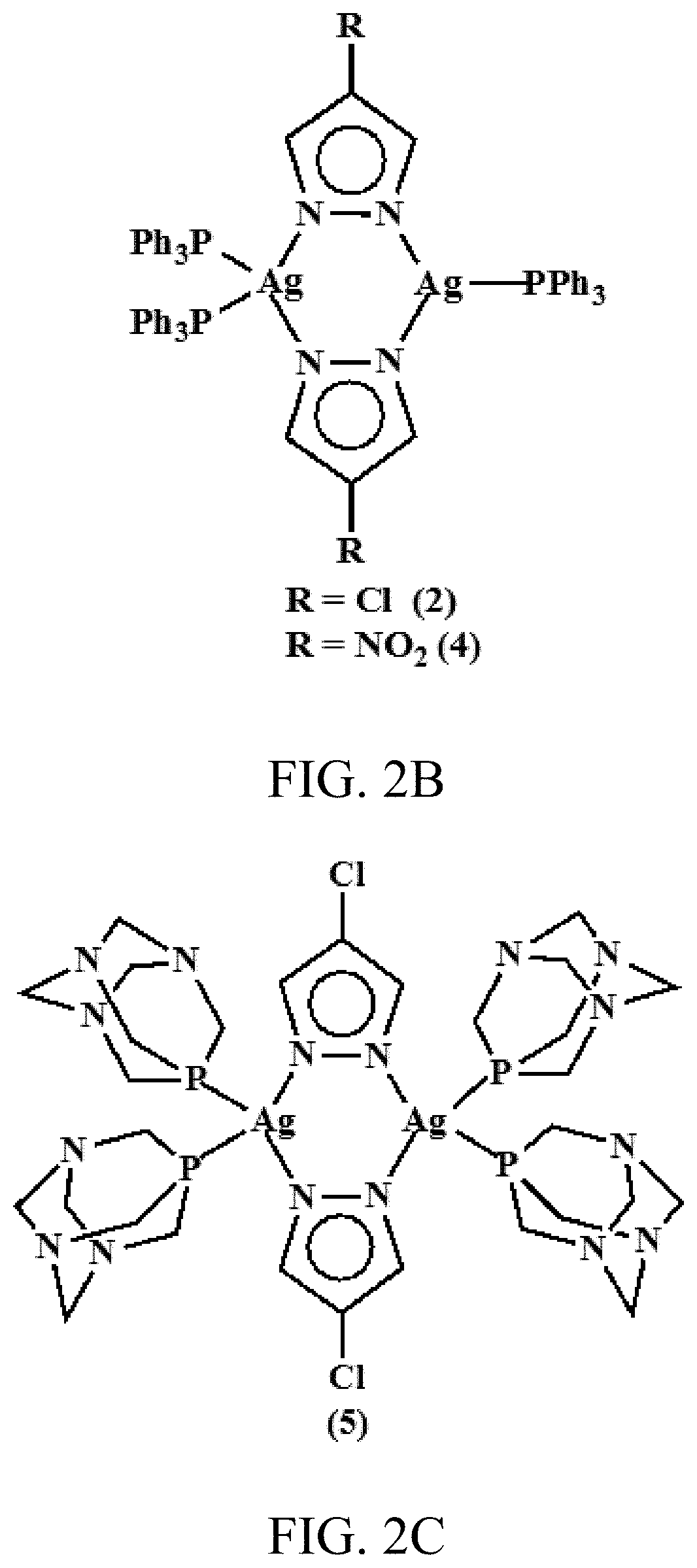Synthesis and antimicrobial uses of dinuclear silver(i) pyrazolates
a technology of dinuclear silver and pyrazolium pyrazolium, which is applied in the direction of antibacterial agents, group 5/15 element organic compounds, and group 1/11 organic compounds without c-metal linkages, etc., can solve the problems of difficult resistance of pathogens, other undesirable side effects, and alarming antibacterial resistance. , to achieve the effect of excellent aqueous solubility, excellent cellular uptake, and excellent lipophilicity
- Summary
- Abstract
- Description
- Claims
- Application Information
AI Technical Summary
Benefits of technology
Problems solved by technology
Method used
Image
Examples
example 1
and Structures of the Complexes
[0141]Reaction of 4-R-pzH (where R=Cl and NO2 and pzH=pyrazole) with silver benzoate in equimolar amounts in dry THF at room temperature uniformly resulted in insoluble polymers, [Ag(R-pz)]n. These polymeric complexes were isolated and suspended in CH2Cl2 solution and reaction with appropriate phosphines (PPh3 and PTA) at ambient temperature resulted in the corresponding dimeric silver complexes (1) to (5). Depending on the amount of the phosphine used in these reactions, either symmetrical or unsymmetrical dinuclear complexes were isolated. For example, when [Ag(R-pz)]n polymers were reacted with 1.5 equivalents per Ag atom of, e.g., triphenylphosphine (PPh3) or 1.5 equivalents per Ag atom of PTA, dimeric silver complexes were generated with two PPh3 groups on a first silver atom and one PPH3 group on a second silver atom or, with two PTA groups on a first silver atom and one PTA group on a second silver atom.
[0142]When [Ag(R-pz)]n polymers were react...
example 7
atterns
[0152]Analysis of the packing patterns for all five complexes reveals no classical hydrogen bonding interactions. In case of both (1) and (5), a relatively weak C—H—Cl intermolecular interactions (with C—Cl, 3.580(5) Å, symmetry code: x+1, y, z+1 for (1) and C—Cl, 3.501(4) Å, symmetry code: x−½, −y+½, z+½ for (5) consolidated their extended structures.
[0153]In case of both (3) and (4), a relatively weak C—H—O intermolecular interactions (with C—O, 3.222(12) Å, symmetry code: x−1, y, z−1 and C—O, 3.329(10) Å, symmetry code: −x+1, −y+1, −z+1 for (3) and C—O, 3.461(6) Å, symmetry code: −x+1, −y, −z+1 for (4) consolidated their extended structures.
example 8
a Collection and Structure Refinement
[0154]Colorless block-shaped crystals of complexes (1) to (5) were obtained by recrystallization through diffusion of hexanes into their dichloromethane (CH2Cl2) solutions. In all cases a suitable crystal was selected and mounted on a Bruker D8 Quest diffractometer equipped with PHOTON 100 detector operating at T=298 K. Data were collected with ω shutter less scan technique using graphite monochromated Mo-Kα radiation (λ=0.71073 Å). The total number of runs and images for data collection was based on strategy calculation from the program APEX3 (Bruker) [36]. Resolution of θ>26° was achieved in all cases. Cell parameters were retrieved using the SAINT (Bruker) software [37] and refined using SAINT (Bruker) on 9960 reflections for complexes (1) and (2), 9056 reflections for complex (3), 9879 reflections for complex (4) and 9926 reflections for complex (5). Data reduction was performed using the SAINT (Bruker) software, which corrects for Lorentz an...
PUM
| Property | Measurement | Unit |
|---|---|---|
| bond angles | aaaaa | aaaaa |
| bond angles | aaaaa | aaaaa |
| bond angles | aaaaa | aaaaa |
Abstract
Description
Claims
Application Information
 Login to View More
Login to View More - R&D
- Intellectual Property
- Life Sciences
- Materials
- Tech Scout
- Unparalleled Data Quality
- Higher Quality Content
- 60% Fewer Hallucinations
Browse by: Latest US Patents, China's latest patents, Technical Efficacy Thesaurus, Application Domain, Technology Topic, Popular Technical Reports.
© 2025 PatSnap. All rights reserved.Legal|Privacy policy|Modern Slavery Act Transparency Statement|Sitemap|About US| Contact US: help@patsnap.com



